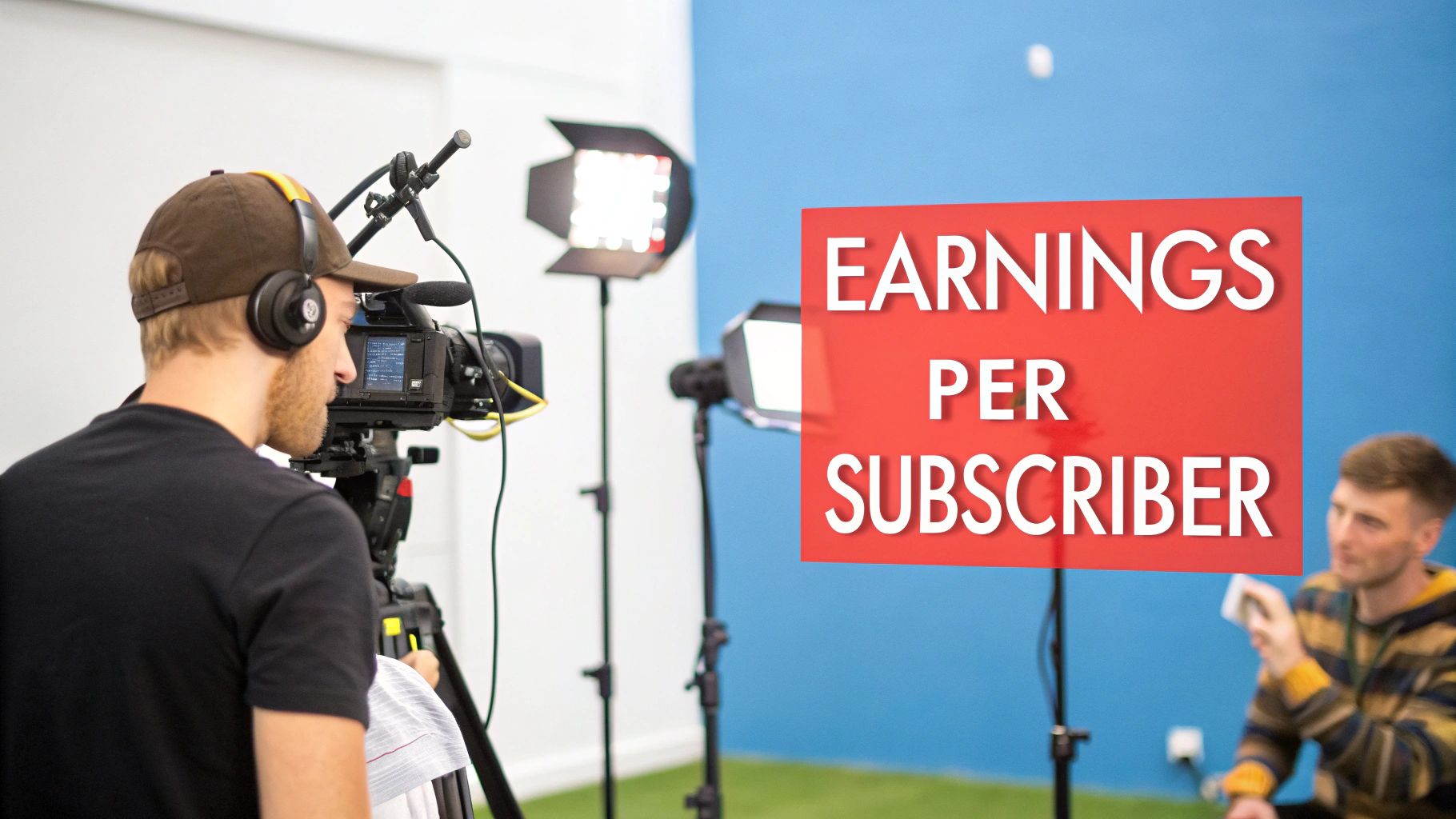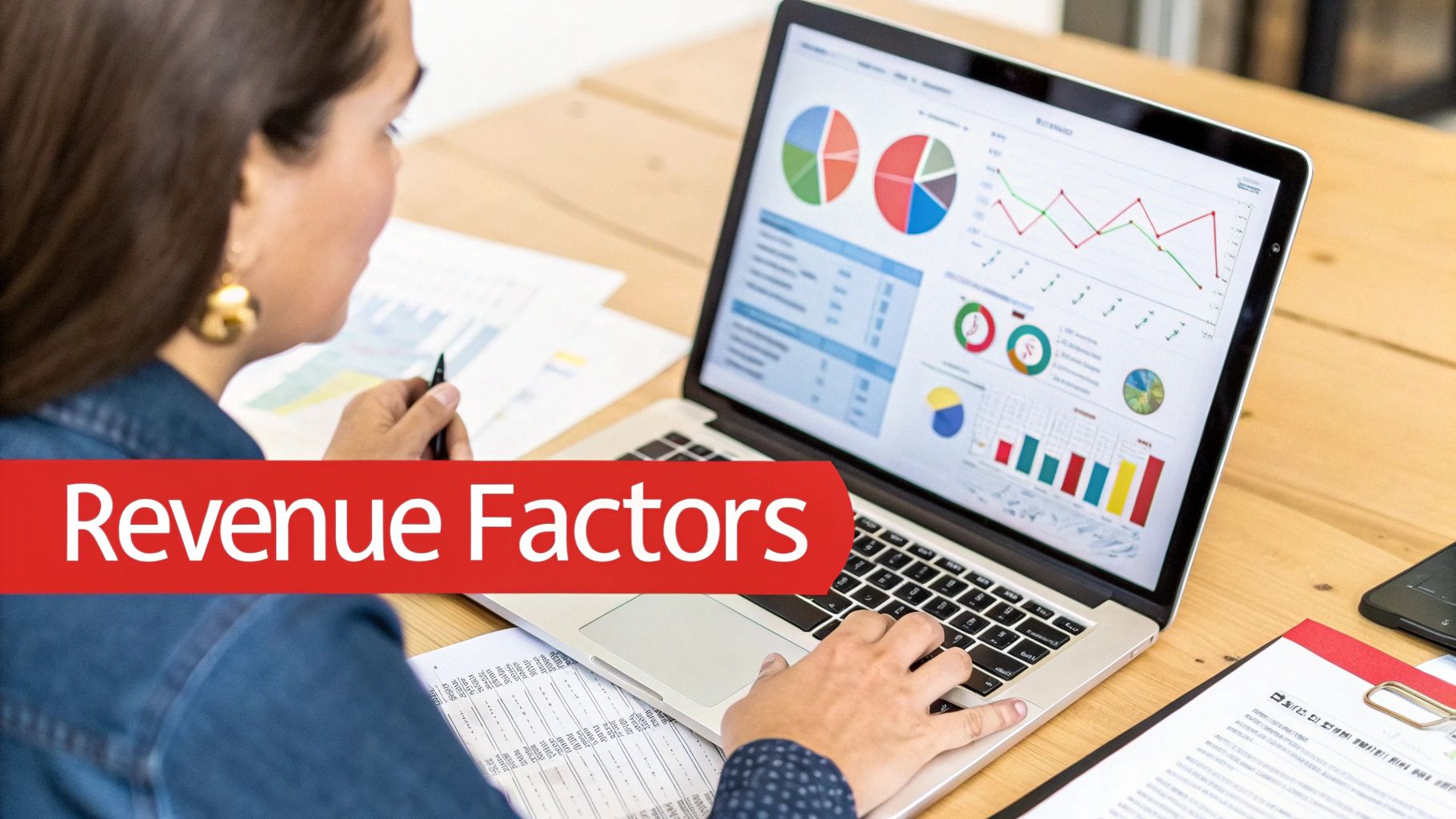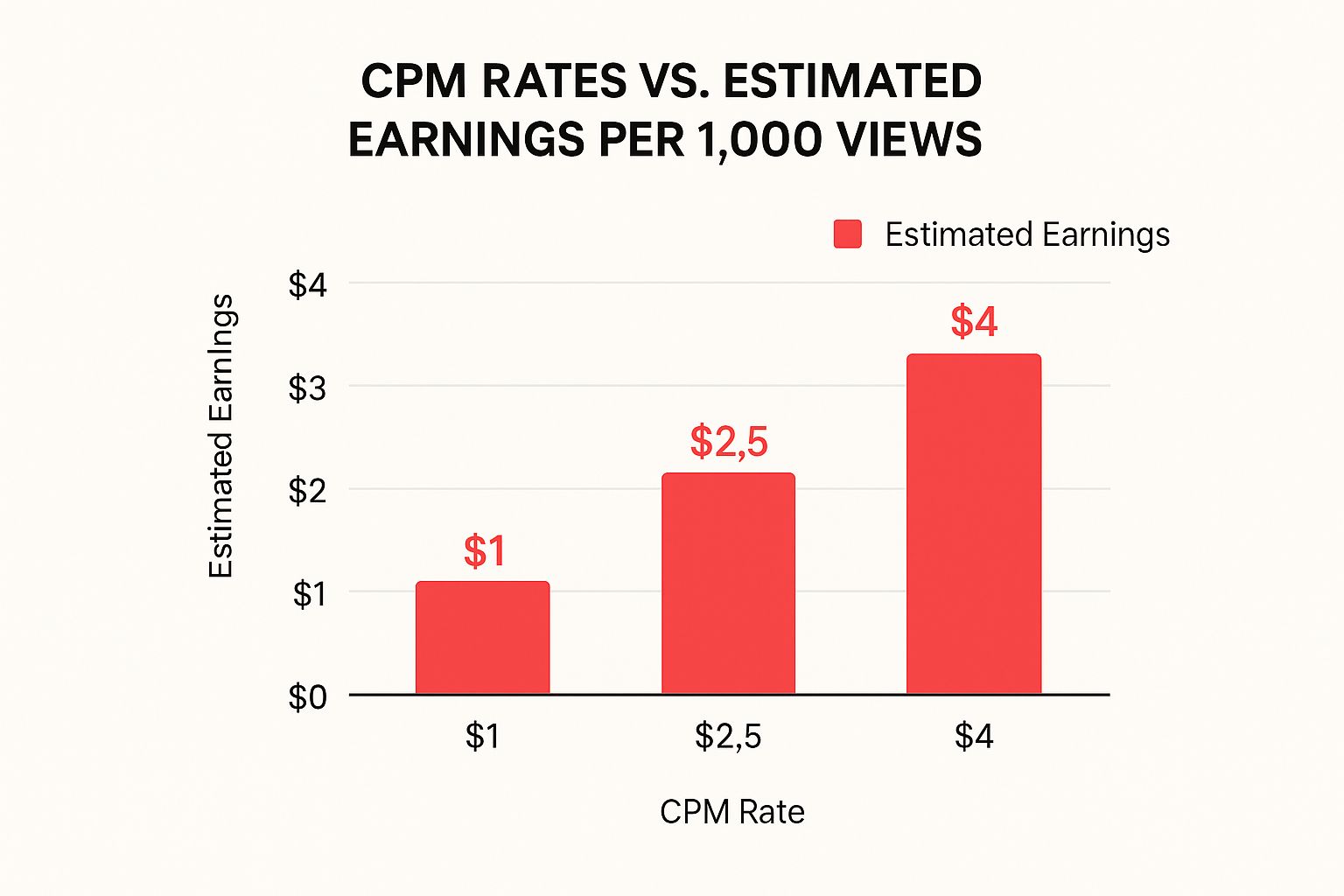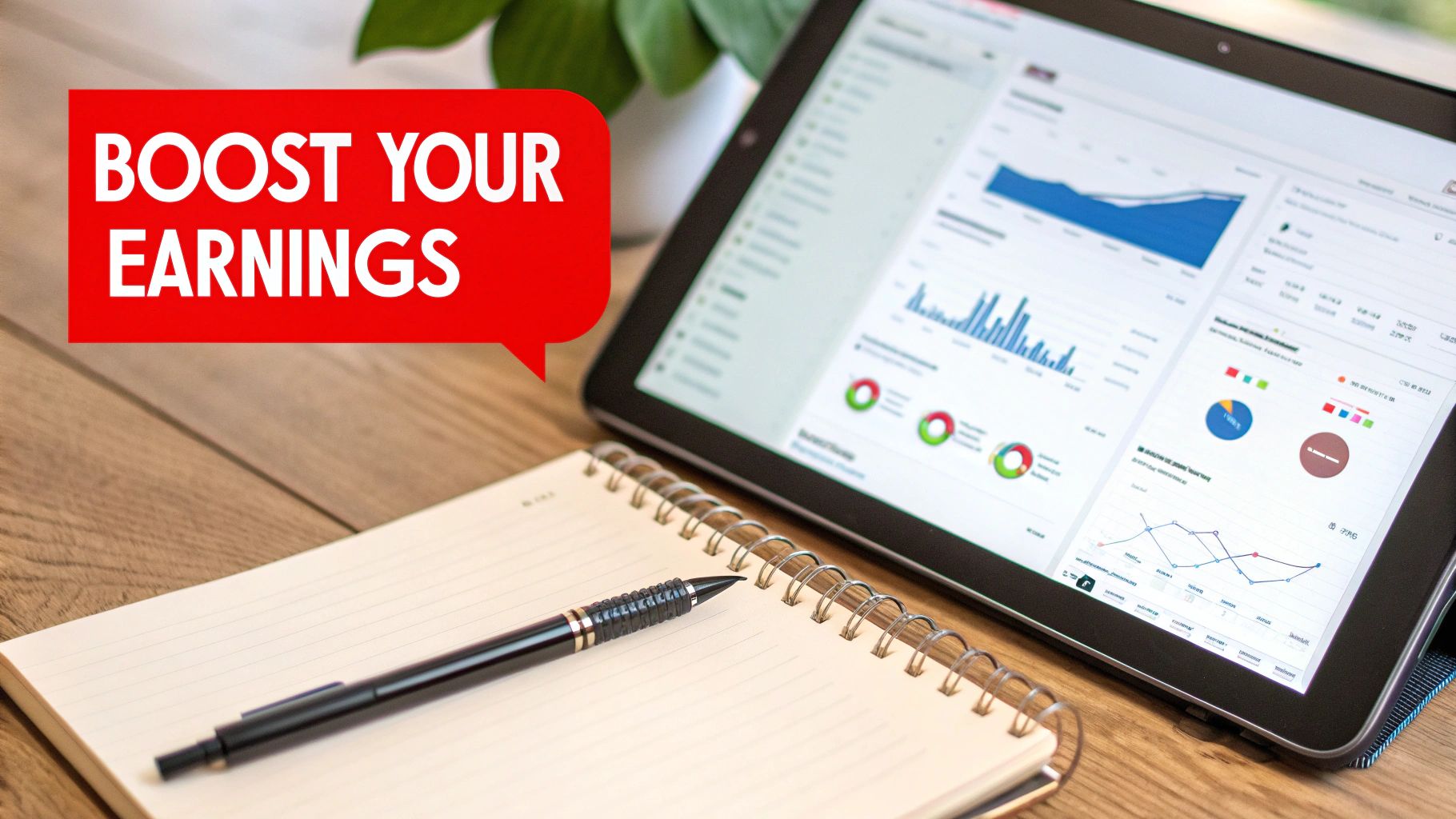Let's get straight to the point: How much does YouTube pay for 1000 subscribers?
The short and simple answer is $0. That’s right, zero. YouTube doesn't pay you for the number of subscribers you have. Instead, hitting 1,000 subscribers is like finding the key that finally unlocks the door to making real money on the platform.
The Real Answer to Your YouTube Earnings Question

It’s one of the biggest myths on YouTube: more subscribers directly means more money in your bank account. The truth is, your subscriber count is a reflection of your community size, not your income.
Think of it like this: getting 1,000 subscribers means you have 1,000 loyal fans who’ve raised their hands to say, "Yes, I want to see what you post next!" They are your core audience, the people most likely to generate the views that advertisers actually pay for.
This milestone, paired with 4,000 hours of public watch time, is what gets your foot in the door for the YouTube Partner Program (YPP). And that is where the money starts.
Key Takeaway: Joining the YPP is the real first step to earning money. Before that, your subscriber count has a monetary value of zero. After you're accepted, your earnings come from ad views, not the number of people subscribed to your channel.
To give you a clearer picture, here’s a quick summary of what these initial milestones really mean for a new creator.
YouTube Monetization at 1000 Subscribers at a Glance
| Metric/Requirement | Typical Range/Value | What It Means for You |
|---|---|---|
| Direct Pay for 1000 Subs | $0 | Subscribers are a sign of potential, not a direct paycheck from YouTube. |
| YouTube Partner Program | Requires 1000 Subs & 4000 Watch Hours | This is the official program you must join to start earning from ads. |
| Monthly Views | 5,000 - 20,000 views | A realistic estimate for a channel of this size, but highly variable. |
| Potential Ad Revenue | $10 - $110 per month | This is where your focus should be. Earnings come from views, not subs. |
This table shows that the journey is just beginning. The real work starts after you get monetized.
Setting Realistic Earning Expectations
So, what can you actually expect to earn once you hit these milestones and join the YPP? Your focus has to shift completely from chasing subscribers to getting views. For a channel just starting out, your income will depend almost entirely on the ad views your videos generate.
Let's break it down with some realistic numbers:
- A brand new channel with 1,000 subscribers might pull in anywhere from 5,000 to 20,000 views per month.
- Based on average ad rates, this could translate into monthly ad revenue of about $10 to $110.
This estimate comes from applying an average CPM (the cost advertisers pay per 1,000 ad impressions) and then factoring in YouTube's 45% cut of the revenue.
Ultimately, reaching 1,000 subscribers is the starting line, not the finish line. It's the moment you can finally start building an income stream, and as you can learn from resources like Podcastle.ai, your path to a bigger paycheck begins by creating great videos that people actually want to watch.
Why Subscribers Are Your Audience, Not Your Bank Account
It's one of the biggest myths on YouTube: a high subscriber count means a fat paycheck. But if you're wondering how much YouTube pays for 1,000 subscribers, the direct answer is... nothing. The reality is far more interesting.
Think of your subscribers as the loyal fanbase for your own TV show. They're the ones who show up for every new episode because they trust you and love what you create. YouTube acts like the TV network, and they pay you for the commercials (ads) your audience watches—not just for the fact that they're subscribed.
The Real Value of 1,000 Subscribers
So, why is that 1,000-subscriber number so important? It’s not a cash prize; it's a key. Specifically, it's one of two keys you need to unlock the door to the YouTube Partner Program (YPP).
The other key is getting 4,000 hours of public watch time. You need both to start earning a single penny from ads. You can see a full breakdown of the current YouTube monetization requirements in our guide.
This is why the goal shouldn't be just chasing a number. It's about building a real community. Every subscriber is giving you a vote of confidence, and that trust is the most valuable thing you can build on the platform.
A loyal subscriber is more likely to:
- Watch your new videos right away.
- Engage by liking, commenting, and sharing.
- Watch the ads on your videos, which is what actually makes you money.
At the end of the day, subscribers are your potential viewership. It's this potential you turn into the actual views that advertisers pay for. They are the foundation of your channel's community, not a direct deposit.
CPM vs. RPM: The Numbers That Actually Drive Your Paycheck

Okay, so if subscribers don't directly put money in your pocket, what does? It all boils down to two key metrics: CPM and RPM. Get a handle on these, and you'll finally understand how YouTube money really works.
Think of it this way: an advertiser pays YouTube to run ads on videos just like yours. The total price they pay for every 1,000 times their ad is shown is the CPM, or Cost Per Mille. It’s the raw, pre-cut figure of what an advertiser is willing to spend.
But you don't get all of that. YouTube takes its slice of the pie for providing the platform and connecting you with those advertisers. Their cut is always 45% of the ad revenue.
RPM: What You Actually Take Home
This brings us to the number you really need to care about: RPM, which stands for Revenue Per Mille. This is your actual income for every 1,000 views on your video, after YouTube has taken its share.
So, while CPM is what advertisers pay, RPM is what you earn. This is why you should live and breathe your channel's RPM—it’s the clearest, most accurate snapshot of your income. It even bundles in all your other potential revenue streams, like Channel Memberships or Super Chats, giving you one tidy metric.
Key Insight: Your RPM is the single best measure of your channel's earning efficiency. A high RPM means you're doing a fantastic job of turning your views into real income.
So what makes your RPM go up or down? Several things have a huge impact:
- Your Audience's Location: Ads shown to viewers in countries with high spending power (like the US, UK, Australia, and Canada) pay a lot more.
- Your Niche: A video about personal finance or software tutorials will almost always attract higher-paying ads than a vlog or a gaming compilation.
- The Time of Year: Advertisers spend big during the holiday season (Q4), which can send CPMs—and your RPM—soaring.
Knowing these factors helps you build a smarter content strategy. If you want to dig even deeper, our guide on what it means to monetize YouTube can unlock your channel's earnings is a great next step.
How Your Niche Can Make or Break Your Earnings
Here’s one of the biggest financial lessons every YouTuber needs to learn: not all views are created equal. It's a tough pill to swallow, but a single view on a finance channel is simply worth more to an advertiser than a view on a gaming or prank channel. This difference is what separates the top earners from everyone else.
Think of it this way: your niche—the specific topic you cover—tells advertisers who is watching. And advertisers are willing to pay a lot more to get their products in front of people who are already primed to buy.
Someone tuning into a video about "how to invest in stocks" is a golden opportunity for a company selling brokerage services. On the other hand, someone watching a funny cat compilation is a much broader, less specific audience. Their eyeballs are still valuable, just not as valuable to a high-ticket advertiser. That's the free market at work on YouTube.
High-Value Niches vs. Low-Value Niches
Your potential earnings come down to a metric called RPM (Revenue Per Mille), and your niche is the single biggest factor that moves this number up or down. Channels in certain topics consistently earn higher ad rates because their viewers are more likely to spend money.
- High-RPM Niches: These are topics like personal finance, technology reviews, software tutorials, real estate, and business strategy.
- Lower-RPM Niches: Think gaming, daily vlogs, entertainment news, and comedy skits.
This doesn't mean you can't make a great living in a lower-RPM niche. You absolutely can. But you'll need way more views to earn what a creator in a high-RPM category makes. That’s why choosing your niche is one of the most critical financial decisions you'll make at the start of your journey.
This earnings gap isn't just theory; it's a documented reality. We see huge differences in what YouTubers earn, even at the 1,000 subscriber level. For example, a finance channel brought in $666.30 in one month from a high RPM of $22. Meanwhile, a gaming channel earned just $172.74 with a $4.93 RPM. You can find more real-world examples and case studies over at vidIQ.
The data makes it crystal clear. Instead of asking "how much does YouTube pay for 1,000 subscribers," you should be asking, "how much will advertisers pay to reach my specific audience?" The answer to that question all comes down to your niche.
Visualizing Your Income Growth Beyond 1,000 Subscribers
Hitting that first 1,000 subscribers is a huge moment, but it's really just the starting line. So, what comes next? This is when your mindset shifts from chasing a milestone to actually building a sustainable business. It’s time to start thinking about your financial path and turning those subscriber goals into real income projections.
The journey from 1,000 to 10,000, 100,000, and even 1 million subscribers is where your hard work really starts to pay off. You’re not just monetized anymore; you’re creating a valuable asset. Understanding how your earnings can multiply at each stage is one of the best ways to stay motivated for the long haul.
This infographic breaks down how your channel's CPM rate—what advertisers pay per 1,000 views—directly impacts what you earn.

As you can see, a higher CPM, which often depends on your content niche, makes every single view more valuable.
Projecting Your Earnings at Key Milestones
What does this growth actually look like in dollars and cents? While your specific niche and RPM play a massive role, we can use some industry averages to get a feel for the potential earnings as your channel grows.
The table below gives a snapshot of how your ad revenue can scale as you hit different subscriber milestones. Remember, these are just averages—your results could be higher or lower depending on your audience and monetization strategy.
Projected Monthly YouTube Earnings by Subscriber Milestones
| Subscriber Count | Projected Average Monthly Earnings |
|---|---|
| 1,000 | $50 - $100 |
| 10,000 | $500 - $1,500 |
| 100,000 | $5,000 - $15,000 |
| 1 million | $50,000 - $250,000 |
These numbers highlight that growing your subscriber base is a long-term game. Each new milestone unlocks a higher tier of earning potential, but getting there takes consistent effort and smart content strategy.
If you're still working on that first major goal, we've got some practical advice to help you get there. Check out our guide on how to reach 1000 subscribers on YouTube for proven tips.
Building a Real Business Beyond Ad Revenue

Putting all your financial eggs in the YouTube AdSense basket is risky. Think of it like a one-legged stool—it's unstable and can topple over at any moment. An algorithm shift, a seasonal dip in ad rates, or an unexpected video demonetization can slash your income overnight.
This is why smart creators don't just have a channel; they build a business. It’s about creating a stable enterprise by looking past what YouTube pays you directly and finding other ways for your audience to support your work. This approach not only secures your finances but also builds a much stronger bond with your community.
Creating Multiple Income Streams
The moment you have an engaged audience—even a small one—you can start adding revenue streams that you actually control. The real goal is to build a brand that can weather a slow ad month without breaking a sweat.
Here are a few of the most popular and effective strategies to get you started:
- Affiliate Marketing: This is a natural fit for most creators. You simply recommend products you genuinely use and love, drop a unique affiliate link in your description, and earn a commission on any resulting sales. It’s a win-win.
- Branded Merchandise: Selling merch like t-shirts, hats, or mugs lets your most dedicated fans fly your flag. It’s a fantastic way for them to show their support while turning your channel into a recognizable brand.
- Digital Products: Do you have a special skill or expertise? Package it up! Creating an e-book, a mini-course, or a set of digital templates allows you to directly monetize the value you bring to your audience.
Key Insight: The most successful YouTubers often make the majority of their money from sources outside of AdSense. This is the critical step that transforms a part-time creator into a full-time business owner.
Beyond these, sponsored content is a huge opportunity for many creators. For a deeper dive into that world, it's worth learning how to get a brand deal.
Got Questions About YouTube Money? We've Got Answers.
Once you hit those big milestones and get monetized, a whole new world of questions opens up. Let's tackle some of the most common things creators ask once they're in the game.
So, Do I Get a Check the Moment I Hit 1,000 Subscribers?
Not quite. Think of hitting 1,000 subscribers and 4,000 watch hours as getting your ticket to the dance. It means you’re eligible to apply for the YouTube Partner Program (YPP), but you're not on the dance floor just yet.
You first have to apply, wait for your channel to be reviewed, and then get the official thumbs-up from YouTube. From there, you'll need to set up a Google AdSense account and switch on monetization for your videos. Your channel only starts earning money after all those steps are done.
How Does the Money Actually Get to My Bank Account?
YouTube works on a monthly payment schedule. The money you earn throughout a given month gets calculated and sent over to your AdSense account around the middle of the following month.
The actual payout happens between the 21st and 26th of that next month. But there's a catch: you'll only get paid if your earnings have hit the payment threshold, which is $100 for most creators.
What if My Subscriber Count Dips Below 1,000? Do I Lose Monetization?
Nope, you can breathe easy on this one. Once you're in the YPP, you won't get automatically removed if your subscriber count takes a small dip below the 1,000 mark.
The real things to watch out for are inactivity and rule-breaking. YouTube can and will remove monetization if a channel goes dormant for six months or violates their community guidelines. The key is to keep creating and stay on the right side of the rules.
Ready to skip the slow grind to 1,000 subscribers and 4,000 watch hours? With MonetizedProfiles, you can get a fully monetized YouTube channel and start earning revenue from day one. Check out our ready-to-go accounts at https://monetizedprofiles.com.








